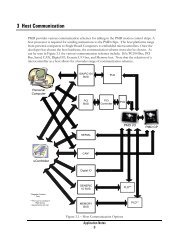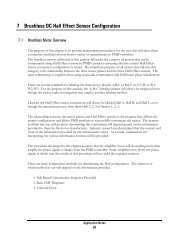New Developments in Commutation & Motor Control [PDF]
New Developments in Commutation & Motor Control [PDF]
New Developments in Commutation & Motor Control [PDF]
You also want an ePaper? Increase the reach of your titles
YUMPU automatically turns print PDFs into web optimized ePapers that Google loves.
<strong>New</strong> <strong>Developments</strong> <strong>in</strong> <strong>Commutation</strong> and<br />
<strong>Motor</strong> <strong>Control</strong> Techniques<br />
Chuck Lew<strong>in</strong>, President & CEO of Performance Motion Devices<br />
TIntroduction<br />
he field of motion control is not generally known for<br />
its headl<strong>in</strong>e-grabb<strong>in</strong>g breakthroughs or fast-paced developments.<br />
<strong>Motor</strong> designs tend to evolve slowly, and<br />
eng<strong>in</strong>eers are understandably cautious when it comes to chang<strong>in</strong>g<br />
time-honored approaches. Lately though, there has been a<br />
beehive of activity around the use of advanced current control<br />
techniques, particularly field oriented control (FOC). This<br />
math-<strong>in</strong>tensive technique for controll<strong>in</strong>g brushless DC and AC<br />
<strong>in</strong>duction motors has become a major focus of the motion<br />
control <strong>in</strong>dustry due to its potential for improved performance<br />
and lower energy consumption.<br />
Field oriented control is a significant improvement over the<br />
standard approach for brushless DC motors of trapezoidal<br />
Hall-based commutation, and it has a speed range advantage<br />
over the more sophisticated technique of s<strong>in</strong>usoidal commutation.<br />
For AC <strong>in</strong>duction motors, FOC is a significant improvement<br />
over standard variable speed drive techniques, and is a<br />
cous<strong>in</strong> of flux vector control, which is a somewhat similar technique<br />
for controll<strong>in</strong>g <strong>in</strong>expensive 3-phase AC <strong>in</strong>duction motors<br />
to get them to perform as if they were more expensive<br />
brushless DC motors. In fact, many vendors use these two<br />
terms <strong>in</strong>terchangeably.<br />
Compared to other servo motor types such as DC brush, which<br />
are still used <strong>in</strong> a number of important applications, brushless<br />
DC and AC <strong>in</strong>duction motors provide greater power density,<br />
much greater reliability, and <strong>in</strong> the case of the AC <strong>in</strong>duction motor,<br />
lower cost. To ga<strong>in</strong> full access to these capabilities, motion<br />
designers are utiliz<strong>in</strong>g fast algorithm platforms <strong>in</strong> the form of<br />
DSP (digital signal processors) and specialized microprocessors<br />
to improve performance, and <strong>in</strong>crease efficiency.<br />
In brushless DC motor applications, higher performance<br />
means smoother motion and greater operat<strong>in</strong>g speed. The potential<br />
for AC <strong>in</strong>duction motors is even more excit<strong>in</strong>g. Compared<br />
to simple “all on/off ” control, FOC means that motors<br />
can be run more efficiently, sized more optimally, and operated<br />
with less heat generation. It also allows features such as direction<br />
reversal, and may allow elim<strong>in</strong>ation of external hardware<br />
such as brakes or clutches. Consider<strong>in</strong>g that 60–65% of all energy<br />
<strong>in</strong> the US is used to drive electric motors, it is no wonder<br />
that the marketplace is <strong>in</strong>creas<strong>in</strong>gly demand<strong>in</strong>g more efficient<br />
motors.<br />
Magnetic attraction<br />
From the standpo<strong>in</strong>t of torque generation, a good work<strong>in</strong>g<br />
model for most motors is the simple bar magnet. The bar magnet<br />
sp<strong>in</strong>s around its center (model<strong>in</strong>g the motor’s rotor) and <strong>in</strong>teracts<br />
with magnet fields generated <strong>in</strong> the stator by fixed, nonmov<strong>in</strong>g<br />
coils. For brushless DC motors the rotor magnetic<br />
field is generated by magnets mounted directly on the rotor.<br />
For AC <strong>in</strong>duction motors the rotor magnetic field is generated<br />
by <strong>in</strong>duction (therefore the name of the motor) from the magnetic<br />
fields <strong>in</strong> the stator. The direction of this magnetic field,<br />
unlike for the brushless DC motor, changes based on several<br />
factors <strong>in</strong>clud<strong>in</strong>g the stator excitation frequency and current,<br />
the rotor speed, and the torque experienced by the motor.<br />
The stator w<strong>in</strong>d<strong>in</strong>gs for brushless DC motors generally come<br />
<strong>in</strong> a 3-phase configuration, as do the w<strong>in</strong>d<strong>in</strong>gs for AC <strong>in</strong>duction<br />
motors used with FOC techniques. Particularly for AC <strong>in</strong>duction<br />
motors it is worth not<strong>in</strong>g that other w<strong>in</strong>d<strong>in</strong>g<br />
configurations are also used, notably the s<strong>in</strong>gle phase AC <strong>in</strong>duction<br />
motor. This motor is the workhorse found <strong>in</strong> most<br />
family A/C units, refrigerators, washers, and dryers, but it does<br />
not lend itself to the most advanced vector control techniques<br />
because the stator w<strong>in</strong>d<strong>in</strong>gs can not be <strong>in</strong>dividually controlled.<br />
In any case, the three stator phases are arranged to be 120 electrical<br />
degrees apart from each other. It is the sum of the force<br />
generated by these three phases that will ultimately generate useable<br />
motor rotation. Depend<strong>in</strong>g on how the <strong>in</strong>dividual magnetic<br />
coils are phased, they can <strong>in</strong>teract to create force that does not<br />
generate rotational torque, or they can create force which does<br />
drive rotation. These two different k<strong>in</strong>ds of force are known as<br />
quadrature (Q) and direct (D), with the useful quadrature forces<br />
(not to be confused with quadrature encod<strong>in</strong>g scheme for position<br />
feedback devices) runn<strong>in</strong>g perpendicular to the pole axis of<br />
the rotor, and the non-torque generat<strong>in</strong>g direct forces runn<strong>in</strong>g<br />
parallel to the rotor’s pole axis. Figure 1 shows this.<br />
The trick to generat<strong>in</strong>g rotation is to maximize Q (quadrature)<br />
while m<strong>in</strong>imiz<strong>in</strong>g D (direct) torque generation. In the case of a<br />
brushless DC motor, this is, at least <strong>in</strong> concept, easy, because<br />
brushless DC motors have magnets mounted directly on the rotor.<br />
Thus if the rotor angle is measured us<strong>in</strong>g a Hall sensor or position<br />
encoder, the direction of the magnetic field from the rotor<br />
is known. Th<strong>in</strong>gs get more <strong>in</strong>terest<strong>in</strong>g for velocity and torque<br />
control applications where sensorless control is attempted. S<strong>in</strong>ce
Figure 1. 3-phase brushless DC motor D (direct) and<br />
Q (quadrature) forces on the rotor<br />
there are no direct mechanical measurements available for the<br />
rotor position, the angle must be <strong>in</strong>ferred from the back-EMF<br />
voltage profile at the three w<strong>in</strong>d<strong>in</strong>gs. Although not trivial, back-<br />
EMF control is fairly common these days. Remember though<br />
that back-EMF requires that the motor be sp<strong>in</strong>n<strong>in</strong>g, so it is not<br />
appropriate for position<strong>in</strong>g applications that must hold at a<br />
steady position.<br />
In the case of an AC <strong>in</strong>duction motor, a similar approach is<br />
used, however because of an additional requirement to ma<strong>in</strong>ta<strong>in</strong><br />
some amount of <strong>in</strong>ductive flux, the D force is not driven<br />
to zero, but <strong>in</strong>stead to a small constant value characteristic of<br />
the motor. Also, measur<strong>in</strong>g the location of the rotor us<strong>in</strong>g Hall<br />
sensors or an encoder is not sufficient to determ<strong>in</strong>e the rotor’s<br />
magnetic angle, because it does not tell us the effective magnetic<br />
field angle generated by the rotor. Recall that this magnetic<br />
field is <strong>in</strong>duced, and thus changes cont<strong>in</strong>uously.<br />
This difference between the rotor location and the rotor magnetic<br />
angle is called the slip angle. The greater the actual torque<br />
on the motor, the greater the amount of slip, and thus the<br />
greater the compensat<strong>in</strong>g torque drive by the motor. This equilibrium<br />
is not unlike the way a hydrostatic transmission works.<br />
The greater the difference <strong>in</strong> speed between the eng<strong>in</strong>e and the<br />
wheels, the greater the torque generated by the transmission.<br />
This means that the motor’s rotation speed will be less than the<br />
driven frequency at the stator.<br />
For the k<strong>in</strong>ds of applications that AC <strong>in</strong>duction is commonly<br />
used <strong>in</strong>, such as A/C units, washers, dryers, etc., a slip-reduced<br />
motor speed is not a problem. But for position<strong>in</strong>g applications,<br />
or to run the motor at its highest level of efficiency, this slip must<br />
be explicitly controlled. There are a few ways to do this, but they<br />
<br />
<br />
2<br />
all require a measurement, or an estimate, of the rotor's <strong>in</strong>duced<br />
electric field. Once aga<strong>in</strong>, a common way to achieve this is by us<strong>in</strong>g<br />
back-EMF techniques. Another popular approach is known<br />
as flux vector control, which measures the mechanical rotor angle,<br />
and attempts to derive the rotor magnetic angle algorithmically<br />
us<strong>in</strong>g estimations for various characteristics of the motor.<br />
Field of oriented control dreams<br />
Field oriented control has become an important drive/commutation<br />
approach for brushless DC motors, and is becom<strong>in</strong>g<br />
that as well for AC <strong>in</strong>duction motors, because it delivers a wide<br />
range of usable motor speeds. It is <strong>in</strong>structive to compare FOC<br />
to the previously most common method for brushless DC motors,<br />
s<strong>in</strong>usoidal commutation.<br />
Figure 2 shows control schemes for both s<strong>in</strong>usoidal commutation<br />
and field oriented control. In the s<strong>in</strong>usoidal control approach,<br />
the torque command is “vectorized” through a<br />
s<strong>in</strong>usoidal lookup table, thereby develop<strong>in</strong>g a separate command<br />
for each w<strong>in</strong>d<strong>in</strong>g of the motor. As the rotor advances,<br />
the lookup angle advances <strong>in</strong> k<strong>in</strong>d. Once the vectorized phase<br />
command is generated, it is passed on to a current loop, one<br />
for each w<strong>in</strong>d<strong>in</strong>g, which attempts to keep the actual w<strong>in</strong>d<strong>in</strong>g<br />
current at the desired current value.<br />
An important feature of this approach is that as the frequency<br />
of motor rotation <strong>in</strong>creases, so does the difficulty of ma<strong>in</strong>ta<strong>in</strong><strong>in</strong>g<br />
the desired current. This is because the current loop directly<br />
“sees” the rotation frequency, and any lag <strong>in</strong> the current<br />
loop, a certa<strong>in</strong> amount of which is <strong>in</strong>evitable, results <strong>in</strong> an error<br />
between the desired stator torque, and the actual. This lag, <strong>in</strong>significant<br />
at low rotation speeds, generates <strong>in</strong>creas<strong>in</strong>g<br />
amounts of D (unwanted) torque at higher rotation speeds, result<strong>in</strong>g<br />
<strong>in</strong> a reduction of available torque.<br />
The control scheme for a field oriented control approach differs<br />
<strong>in</strong> that the current loop occurs de-referenced from the motor’s<br />
rotation. That is, <strong>in</strong>dependent of the motor’s rotation. In<br />
the FOC approach there are two actual current loops, one for<br />
the Q torque, and one for the D torque. The Q torque loop is<br />
driven with the user’s desired torque from the servo controller.<br />
The D loop is driven with an <strong>in</strong>put command of zero, so as to<br />
m<strong>in</strong>imize the unwanted direct torque component.<br />
The trick to mak<strong>in</strong>g all of this work are math-<strong>in</strong>tensive transform<br />
operations known as Park and Clarke transforms that convert<br />
the vectorized phase angle <strong>in</strong>to the de-referenced D and Q<br />
reference frame. This is done twice, once to convert the output<br />
of the D and Q control loops <strong>in</strong>to the 3-phase motor command,<br />
and once to convert the measurement of the rotor’s angle back<br />
<strong>in</strong>to the D and Q frame. While these transforms have been<br />
known about for years, their practical implementation <strong>in</strong> brushless<br />
DC and AC <strong>in</strong>duction drives has awaited the availability of<br />
cheap, high performance DSPs and microprocessors.<br />
Now that these are available, AC <strong>in</strong>duction motors which utilize<br />
an FOC approach can develop motor efficiencies of
Figure 2. Overviews of s<strong>in</strong>usoidal commutation (2A) and field oriented control schemes (2B)<br />
85+%, compared to around 60% for non field-oriented approaches.<br />
brushless motors which adopt an FOC approach, by<br />
comparison, can achieve even higher efficiencies of up to 95%.<br />
S<strong>in</strong>usoidal commutation for brushless DC motors also works<br />
very efficiently, but is not as efficient as FOC at the very highest<br />
speed range of the motor.<br />
Where the magnetic field hits the road<br />
Practically speak<strong>in</strong>g, your selection of motor and amplifier will<br />
often dictate the control technique that you will use.<br />
If you are us<strong>in</strong>g a brushless DC motor for position<strong>in</strong>g, then sensorless<br />
control is not an option. You will need an encoder and<br />
most likely a Hall sensor as well. If you want to ga<strong>in</strong> the maximum<br />
performance from your motor you will gravitate toward<br />
field oriented control. However unless you are prepared to build<br />
your own amplifier (a daunt<strong>in</strong>g task for most) you will purchase<br />
a packaged drive with this feature built <strong>in</strong>.<br />
<br />
<br />
<br />
<br />
<br />
<br />
<br />
<br />
<br />
<br />
<br />
<br />
<br />
<br />
<br />
<br />
<br />
<br />
<br />
<br />
<br />
<br />
<br />
<br />
<br />
<br />
<br />
<br />
<br />
<br />
<br />
<br />
<br />
3<br />
In this configuration the drive generally <strong>in</strong>cludes high-level motion<br />
control functions such as profile generation, position servo<br />
loop, and PLC-style <strong>in</strong>puts and outputs. There are a number of<br />
compact, s<strong>in</strong>gle axis drives that offer Hall-based, s<strong>in</strong>usoidal, or<br />
field oriented control. These drives are typically located on a<br />
RS/485, CANbus, Ethernet, or other serial bus. All you need to<br />
do is hook up the motor and power, and send commands.<br />
If you are us<strong>in</strong>g a card-based approach, either one that you have<br />
purchased, or one that you have designed yourself, your ability<br />
to adopt field oriented control is limited. This is because most<br />
off-the-shelf amplifiers <strong>in</strong>put an analog +/- 10Volt control signal<br />
and do not provide field oriented control. The ones that do<br />
are generally expensive, because they <strong>in</strong>clude a lot of features<br />
that you will not be us<strong>in</strong>g by hav<strong>in</strong>g a separate motion card.<br />
There is good news however, which is that there are a number<br />
of vendors which offer s<strong>in</strong>usoidal commutation control. This<br />
can be done <strong>in</strong> the motion card by outputt<strong>in</strong>g two analog +/-<br />
10V signals represent<strong>in</strong>g the A and B phase desired current. For
many applications s<strong>in</strong>usoidal commutation provides a huge improvement<br />
over 6-step Hall based commutation, and is still an<br />
excellent choice for a wide range of motion applications.<br />
If you are us<strong>in</strong>g brushless DC motors for velocity control applications,<br />
such as <strong>in</strong> centrifuges, tape drives, or other non-position<strong>in</strong>g<br />
applications, you have a number of design options.<br />
Sensorless control is certa<strong>in</strong>ly a possibility, although drives that<br />
offer sensorless field oriented control are still rare. More common<br />
are sensorless drives that provide a s<strong>in</strong>usoid-like commutation<br />
function. These can be purchased at the IC level, or at the<br />
drive level.<br />
If you are work<strong>in</strong>g with AC <strong>in</strong>duction motors, you are probably<br />
design<strong>in</strong>g for a velocity or torque control applications rather<br />
than position<strong>in</strong>g applications. Much discussed <strong>in</strong> technical journals,<br />
practical examples of AC <strong>in</strong>duction motors be<strong>in</strong>g used as<br />
position<strong>in</strong>g are rare except for some specialized doma<strong>in</strong>s such as<br />
very high power drives.<br />
In any case, you have many choices, but they generally break down<br />
<strong>in</strong>to a “design it yourself ” approach, or a “buy the drive” approach.<br />
If you decide to buy a drive, you have a range of performance<br />
levels to choose from beg<strong>in</strong>n<strong>in</strong>g at simple speed control<br />
<strong>in</strong>verters, to very sophisticated field oriented and flux vector<br />
drives.<br />
If you decide to build your own controller card or amplifier, simple<br />
variable speed control is not that difficult to achieve if you<br />
are familiar with basic <strong>in</strong>verter design and MOSFET or IGBT<br />
switch<strong>in</strong>g techniques. For more advanced designs you can look<br />
to available off-the-shelf ICs to perform field oriented control<br />
for AC <strong>in</strong>duction motors.<br />
Summary<br />
<strong>Developments</strong> <strong>in</strong> control techniques, a grow<strong>in</strong>g demand for<br />
energy efficiency, and newly available low cost DSPs and microprocessors,<br />
have comb<strong>in</strong>ed to significantly raise the bar for<br />
brushless DC and AC <strong>in</strong>duction motor performance. Whether<br />
you build your own controller or buy off-the-shelf, know<strong>in</strong>g<br />
how to implement these new approaches is important for maximiz<strong>in</strong>g<br />
cost effectiveness, and m<strong>in</strong>imiz<strong>in</strong>g project design<br />
times.<br />
Performance Motion Devices, Inc<br />
55 Old Bedford Road<br />
L<strong>in</strong>coln, MA 01773<br />
e-mail: <strong>in</strong>fo@pmdcorp.com<br />
www.pmdcorp.com<br />
OEMs steer toward<br />
<strong>in</strong>telligent drives<br />
4<br />
Off-the-shelf programmable drives emerged more than thirty years<br />
ago and were used for applications such as mach<strong>in</strong>e tools and<br />
factory-floor automation. While robust, they were expensive and<br />
awkward to program. OEMs design<strong>in</strong>g lower power and more cost<br />
sensitive mach<strong>in</strong>es have typically steered clear of these “big iron”<br />
solutions <strong>in</strong> preference to IC or card-based solutions. But now they<br />
are tak<strong>in</strong>g a closer look at the latest generation of <strong>in</strong>telligent drives.<br />
Compact and powerful, these products comb<strong>in</strong>e low cost, network<br />
connectivity, and sophisticated motion capability. The ION digital<br />
drive from PMD is an example of such a product. Measur<strong>in</strong>g just 4"<br />
x 3" x 1.5" (slightly larger than a deck of pay<strong>in</strong>g cards) this product<br />
offers serial or CANbus connectivity and can control DC brush,<br />
brushless DC, or step motors. It has features typically found <strong>in</strong> much<br />
larger drives <strong>in</strong>clud<strong>in</strong>g field oriented control, S-curve profil<strong>in</strong>g, PID<br />
position loop with bi-quad filter<strong>in</strong>g, and ultra efficient MOSFET<br />
drivers.<br />
The most eye open<strong>in</strong>g aspect of these products is their price. At<br />
$200–$500 per axis, they compare favorably to the alternative<br />
approach of motion cards with purchased amplifiers, and are more<br />
scalable. Add<strong>in</strong>g an axis is a simple matter of <strong>in</strong>stall<strong>in</strong>g another drive.<br />
In card-based systems, add<strong>in</strong>g an axis can mean the purchase of a<br />
larger card and unused axis capacity.<br />
About Performance Motion Devices<br />
Performance Motion Devices (PMD) is the recognized world leader<br />
<strong>in</strong> motion control ICs, cards, and modules. Dedicated to provid<strong>in</strong>g<br />
cost-effective, high performance motion systems to OEM customers,<br />
PMD utilizes extensive <strong>in</strong>-house expertise to m<strong>in</strong>imize time-tomarket<br />
and maximize customer satisfaction.<br />
Prodigy, ION, Magellan, Navigator, Pilot, Pro-Motion, and C-Motion are trademarks of Performance Motion Devices, Inc. All other trade<br />
names, brand names, and company names are the property of their respective owners.<br />
© 2007 Performance Motion Devices Inc.


![New Developments in Commutation & Motor Control [PDF]](https://img.yumpu.com/17401848/1/500x640/new-developments-in-commutation-amp-motor-control-pdf.jpg)
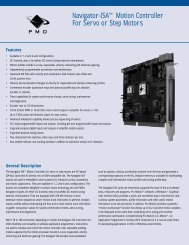
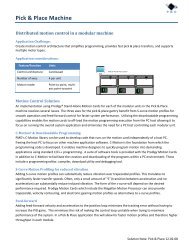
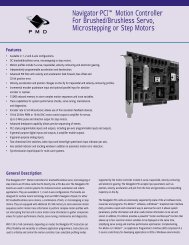
![Navigator MC2800 Datasheet [PDF] - Performance Motion Devices](https://img.yumpu.com/25398470/1/190x245/navigator-mc2800-datasheet-pdf-performance-motion-devices.jpg?quality=85)
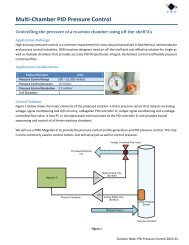
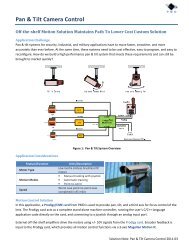
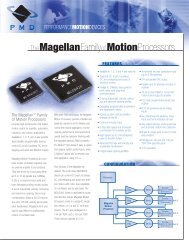
![Motion Control has a Field Day [PDF] - Performance Motion Devices](https://img.yumpu.com/22926252/1/190x245/motion-control-has-a-field-day-pdf-performance-motion-devices.jpg?quality=85)
